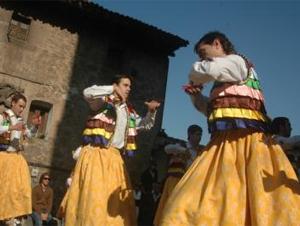The resurgence of stilt dancing in Spain
(image: Gerry Haden)
Twenty-five-year-old local Pablo Gonzalo: "Here in Anguiano, you start wearing stilts when you’re just a little kid. You put them on and off you go… running around and throwing yourself off of anything you can."
That’s in essence what Gonzalo and seven other stilt dancers are about to do. But first the entire village gathers at the church to carry the effigy of Saint Mary Magdalene two miles up the mountain to a small stone chapel.
Hadden: Here the saint will spend the winter. When its time to plant next year’s bean crop, the Anguianos will bring her back to town. The turn out this year is bigger than anyone can remember. Anguiano’s bean farmers are already hurting …as are small farmers across Europe. And there’s worry that if the global economy sours further, and government tax revenues fall,farm subsidies might dry up.
Back in town the stilt dancers prepare to sacrifice themselves to Mary Magdalene, in return for a bountiful harvest. They’re poised at the top of a long, steep cobblestone lane. If this were a ski slope we’d be talking ‘for experts only.’
The dancers begin to whirl in place like dervishes. Waiting his turn, Pablo Gonzalo admits to a case of the nerves.
Gonzalo: "Some of us make it down okay, others wipe out. We have people lining the sides to break our fall but still. You don’t know if your stilts are going to betray you. I get the butterflies."
Then, one by one, they stilt dancers twirl down the hill. The people lining the steep descent push themselves against the walls to keep from being run over. At the bottom the dancers hurl themselves down a staircase and into the waiting arms of fellow villagers. When its over a fellow dancer Antonio says the experience is out of body…like communing directly with God.
Antonio: "You just lose yourself. Some us do it because of our devotion to the saint, others because its fun and a tradition. And we have to keep it alive."
Like many rituals, the roots of the stilt dancing harkens back to something more practical. Keeping your shoes clean. The town is on a steep slope, points out Manolo, the owner of a local bar.
Manolo: "For centuries there was no pavement in town. So when it rained the stone lanes would fill up with mud from the mountain. The only way to get around was on stilts."
Today most of the streets are paved. There are storm drains. But with the global economy mired in the financial mud the Anguianos keep their stilts…and their saint…at the ready.
PRI’s "The World" is a one-hour, weekday radio news magazine offering a mix of news, features, interviews, and music from around the globe. "The World" is a co-production of the BBC World Service, PRI and WGBH Boston.
